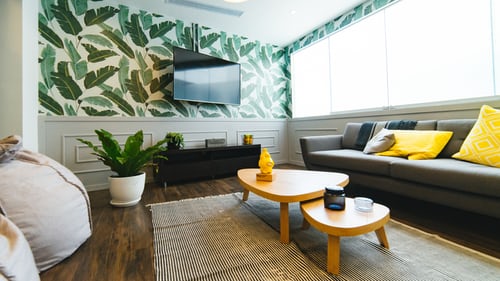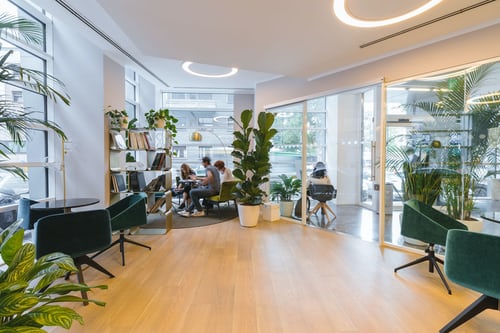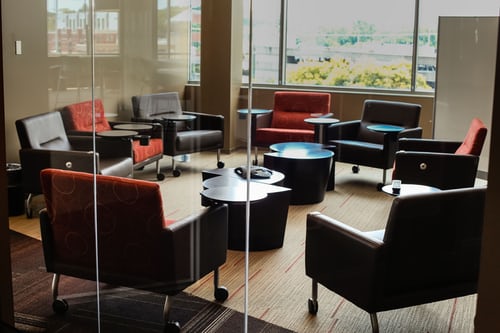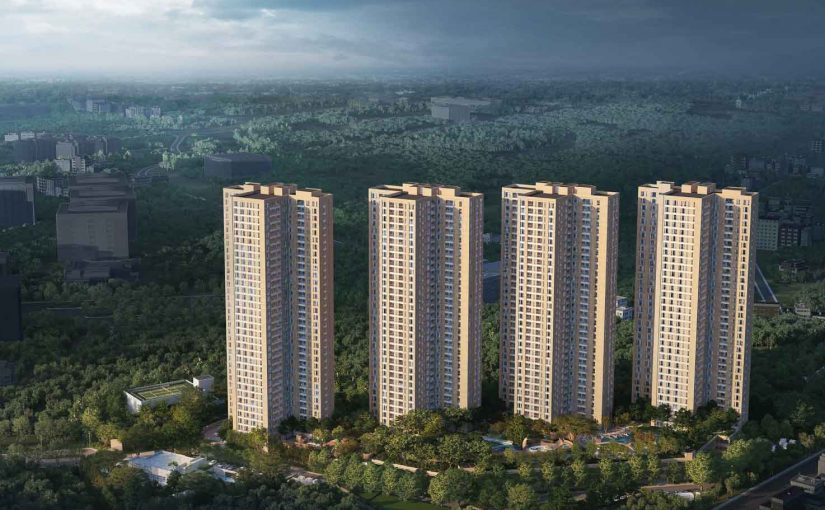By
|
Getting your Trinity Audio player ready...
|
The COVID-19 pandemic has been a revolutionary phase bringing about a series of changes in all business sectors across the world. Staying at home due to the unprecedented and prolonged lockdown made the culture of Work of Home (WFH) popular. Although WFH was previously considered unsuitable across several business sectors, instant technological adaptations to digital tools made remote working possible.
Changing Real Estate Markets: working and staying at home

The pandemic thus led businesses to re-evaluate their commercial real estate strategy and made it more resilient to changes. As there are to every situation, WFH also has its own set of pros and cons. While on one hand, this new way of life is saving travel time and people don’t have to worry about getting stuck in traffic jams, the new work trend is raising concerns over employee privacy, with real-time activity tracking, record screens, and other tracking software.
1. Coworking spaces experience resurgence amid the pandemic
With companies resuming businesses slowly but surely, and with the relaxation of rules, companies are opting for flexible work options for their employees to enhance productivity and effectiveness. This shift in traditional working culture has brought about a burgeoning demand for coworking spaces in the real estate sector of India, especially in the post-lockdown period. It wouldn’t be entirely wrong to say that the pandemic has contributed to the resurgence of demand in coworking spaces, as people are compelled to adapt to a new style of working that includes flexible hours, and workspaces closer to home.
While staying at home and the WFH model was the need of the hour during the lockdown, several companies do not want to make WFH a culture. Furthermore, many business verticals and operations require employees to work in an office setting. This has further accelerated the demand in the coworking segment. WFH may co-exist, but office space has not yet lost its importance.
2. Developers offer coworking space segment while staying at home
With most of the country’s population staying at home, offering co-working spaces has become an added feature in the residential segment. But, working from home also means giving in to distractions. With prolonged lockdown and reservations to assembling in big groups at offices, people are facing not only space, but also infrastructural constraints. Aligning with the new realities of WFH, several developers are thus offering coworking spaces in clubhouses, or are adding this feature at the initial design phase for upcoming housing projects. The possibility of incorporating co-working spaces in existing infrastructure also calls for retrofitting coworking spaces— which means doing key modifications in structures that were originally reserved for community or socializing activities, such as indoor games, spas, etc.
The other possibility of offering co-working spaces as an add-on feature in-house coworking spaces at the initial design stage. This is helping to attract buyers and the housing projects are also getting a commercial boost. Furthermore, developers can sell their projects faster.
Real estate developers are further exploring the co-working space segment and attracting not only in-house clientele, but buyers from beyond the captive zone. In such a case, the success of the project depends most likely on the location. In order to attract both resident and external clients, real estate projects with dedicated co-working spaces must be located closer to major office hubs, public transport, and residential societies. The rentals in the case of in-house co-working spaces and external space may vary depending on the type of facilities that are offered. However, one thing is for sure, coworking spaces offer much lower rentals than the conventional commercial spaces, in addition to offering infrastructural facilities that are suitable for workspaces such as high-speed internet, waiting areas, flexible workstations, etc.
Home and safety go hand in hand
Health, family, and safety have topped the list of priorities for people around the world in the pandemic; a home is just the place where one can find such intangible priorities under one roof. One of the most significant driving factors fostering the demand for real estate therefore is — safety. With people spending more time at home from the fear of the pandemic, the ‘stay home save life’ aspect made people appreciate and realize the value of owning a house, thus adding to the real estate business. Furthermore, with people working increasingly from home during COVID-19, they are seeing the benefits of owning a house, rather than a rented accommodation.
The new normal of owning an office space at home has also surged the demand for buying own properties among middle-income and upper-middle-income groups. The affluent classes are also looking for properties with amenities like rec rooms, or flex spaces, swimming pools, home gyms and private home office space. With this definite shift in end-user preference, home buyers are looking for bigger accommodations.
Contribution of PS Group to coworking spaces

For over three decades, PS Group has been effortlessly providing affordable and quality living for homebuyers, thus making it one of the topmost recognized real estate companies in Kolkata. PS Group has received over 100 awards from the West Bengal Real Estate Developers Association. Housing projects of PS Group have amenities, safety, green initiative, and flexibility to volatile market changes as its top tenets. Below are some projects initiated by PS Group when WFH became the new norm:
PS One10, Flats in Rajarhat New Town
Awarded a gold certificate by IGBC, One 10 sprawls over 9 acres and provides luxury 2 and 3 BHK flats along with coworking spaces and business lounge. Known as the largest residential development in New Town Action Area I — One10 focuses on the recreational needs of children. It boasts of 70% open area and 50% of lush greenery. Furthermore, One10 is a stone’s throw away from the under-construction Metro. A 2 BHK flat at One10 will cost you 66 lakhs onwards while a 3 BHK starts at 73 lakhs.
The biggest advantage of PS One is its location. It is a stone’s throw away from Kolkata’s IT hub. Along with several amenities such as wellness center, cabanas, cycling tracks, nature trail, outdoor theater, convenience store, ATM, pet zone and pharmacy — PS one also offers banquet halls and coworking spaces and a business lounge.
Amistad in New Town Action Area II
Amistad was voted the Best Upcoming Mid-segment Residential Project of the Year by CREDAI Bengal Realty Awards in 2018. It is close to IT hubs in New Town and Salt Lake City. Located in Action Area II, Amistad has all the opportunities of education, healthcare and leisure. Furthermore, the project focuses on balancing urban living. In addition to offering co-working spaces, it also includes amenities such as mini theatre, gymnasium, yoga and meditation room, squash court, steam and sauna room, landscaped gardens, gazebos, swimming pool and badminton court.
Abacus Offices at New Town, Opp. Auto Mall
With 65% open spaces, 200 trees served with alfresco dining, ample parking, advanced security and internal traffic management system, proximity to hubs, transport stations and utility stores, Abacus by PS Group is the most coveted Grade A Business Park in prime New Town, Action Area II. Premium offices in Abacus cost Rs. 71 Lacs onwards.
The coworking segment needs support for better reach across the country

As coworking spaces are contributing vitally to the economic growth of the country, the real estate sector is seeking recognition from the Government to include it under its special scheme programmes such as Real Estate Investment Trust (REIT). Developers are also hoping to seek tax benefits to handhold better growth opportunities in the industry. Furthermore, by providing suitable infrastructure status, coworking spaces will ensure easier access to institutional credit, which will further also simplify the approval process and thus reduce the developer’s cost of borrowing. With the anticipated financial incentives from the government, the coworking sector is likely to expand across the country’s real estate, especially in Tier 2 and 3 markets. Furthermore, if banks approve loans to co-working firms, the funding in the sector will increase and will open up lucrative investment opportunities for investors of the coworking spaces. New reform and benefits will finally drive the growth and demand for flexible workspaces and relieve the real estate industry from the liquidity crunch witnessed during the pandemic period.
The challenges of the coworking segment

Although businesses are gradually opening up, people still prefer staying at home and have reservations about commuting to work. Venturing out to co-working spaces also means getting in contact with foreign people. Although co-working spaces are offering people flexibility and catering to their needs, such spaces need to abide by safety and health regulations, in addition to incorporating stringent risk management and control measures to maintain occupancy levels and to keep the environment safe and secure for employees.
In closing
As staying at home is limited to the pandemic period, real estate experts estimate the demand for in-house coworking spaces to be temporary and limited to the pandemic. With relaxation in norms, workspaces are already opening up and a significant number of the workforce that was previously working from home is returning to their offices.
However, this trend of returning migration would not impact larger co-working spaces that are incorporating infrastructural amenities and attracting clientele by offering the previously missing community feeling in office environments. Furthermore, such larger coworking spaces are built for commercial growth and are keeping up with the outside competition by drawing footfalls from all around. Only time will tell, how the demand for large coworking spaces and coworking stations built exclusively for residents will be post-pandemic and when more people return to offices again.
Leave a comment







